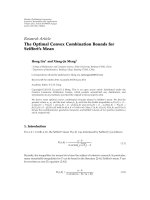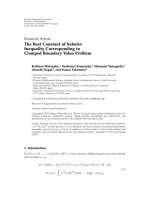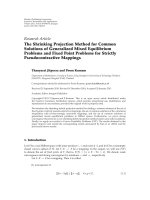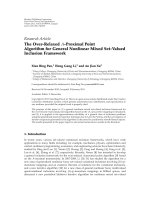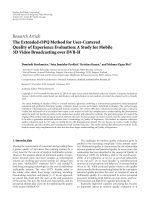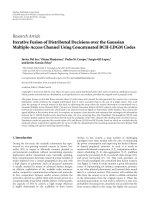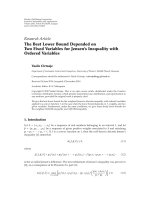Báo cáo hóa học: " Research Article The Existence of Positive Solution to a Nonlinear Fractional Differential Equation with Integral Boundary Conditions" potx
Bạn đang xem bản rút gọn của tài liệu. Xem và tải ngay bản đầy đủ của tài liệu tại đây (513.47 KB, 14 trang )
Hindawi Publishing Corporation
Advances in Difference Equations
Volume 2011, Article ID 546038, 14 pages
doi:10.1155/2011/546038
Research Article
The Existence of Positive Solution to
a Nonlinear Fractional Differential Equation
with Integral Boundary Conditions
Meiqiang Feng,
1
Xiaofang Liu,
1
and Hanying Feng
2
1
School of Applied Science, Beijing Information Science & Technology University, Beijing, 100192, China
2
Department of Mathematics, Shijiazhuang Mechanical Engineering College, Shijiazhuang 050003, China
Correspondence should be addressed to Meiqiang Feng,
Received 19 December 2010; Accepted 26 January 2011
Academic Editor: J. J. Trujillo
Copyright q 2011 Meiqiang Feng et al. This is an open access article distributed under the Creative
Commons Attribution License, which permits unrestricted use, distribution, and reproduction in
any medium, provided the original work is properly cited.
The expression and properties of Green’s function for a class of nonlinear fractional differential
equations with integral boundary conditions are studied and employed to obtain some results on
the existence of positive solutions by using fixed point theorem in cones. The proofs are based upon
the reduction of problem considered to the equivalent Fredholm integral equation of second kind.
The results significantly extend and improve many known results even for integer-order cases.
1. Introduction
Fractional calculus is an area having a long history, its infancy dates back to three hundred
years, the beginnings of classical calculus. It had attracted the interest of many old famous
mathematicians, such as L’Hospital, Leibniz, Liouville, Riemann, Gr
¨
unward, Letnikov, and
so forth 1, 2. As the old mathematicians expected, in recent several decades fractional
differential equations have been found to be a powerful tool in more and more fields, such
as materials, physics, mechanics, and engineering 1–5. For the basic theory and recent
development of the subject, we refer the reader to a text by Lakshmikantham et al. 6. For
more details and examples, see 7–24 and the references therein. However, the theory of
boundary value problems for nonlinear fractional differential equations is still in the initial
stages, and many aspects of this theory need to be explored. In 13, Bai and L
¨
u used the fixed
point theorems to show the existence and multiplicity of positive solutions to the nonlinear
fractional boundary value problem
D
α
u
t
f
t, u
t
0, 0 <t<1,
u
0
0,u
1
0,
1.1
2 Advances in Difference Equations
where 1 <α≤ 2, D
α
is the standard Riemann-Liouville differentiation, and f : 0, 1×0, ∞ →
0, ∞ is a given continuous function.
In 15, Zhang showed the existence and multiplicity of positive solutions of the
fractional boundary value problem
D
α
0
u
t
f
t, u
t
, 0 <t<1,
u
0
u
0
0,u
1
u
1
0,
1.2
where 1 <α≤ 2 is a real number, and D
α
0
is the Caputo’s fractional derivative. The function
f is continuous on 0, 1 × 0, ∞.
Recently, Ahmad and Nieto 11 investigated some existence results for a nonlinear
fractional integrodifferential equation with integral boundary conditions
c
D
q
x
t
f
t, x
t
,
χx
t
0, 0 <t<1, 1 <q≤ 2,
αx
0
βx
0
1
0
q
1
x
s
ds,
αx
1
βx
1
1
0
q
2
x
s
ds,
1.3
where
c
D
q
is the Caputo fractional derivative, f : 0, 1 × X × X → X,for : 0, 1 × 0, 1 →
0, ∞,
χx
1
0
t, s
x
s
,
1.4
q
1
,q
2
: X → X, α>0, β ≥ 0 are real numbers, and X is a Banach space.
Being directly inspired by 11, 13, 15, we intend in this paper to study the following
boundary value problems of fractional order differential equation
D
α
0
x
t
g
t
f
t, x
0, 0 <t<1,
x
0
0,x
1
1
0
h
t
x
t
dt,
1.5
where 1 <α≤ 2, g ∈ C0, 1, 0, ∞ and g may be singular at t 0or/andatt 1, D
α
0
is
the standard Riemann-Liouville differentiation, h ∈ L
1
0, 1 is nonnegative, and f ∈ C0, 1×
0, ∞, 0, ∞.
In the case of ht ≡ 0, for all t ∈ 0, 1, boundary value problem 1.5 reduces to the
problem studied by Kaufmann and Mboumi 19.In19, the authors used the fixed point
theorems to show sufficient conditions for the existence of at least one and at least three
positive solutions to problem 1.5. For the case of α 2, boundary value problem 1.5 is
related to a boundary value problems of integer-order differential equation. Feng et al. 25
considered the existence and multiplicity of positive solutions to boundary value problem
1.5 by applying the fixed point theory in a cone for strict set contraction operators.
Advances in Difference Equations 3
The organization of this paper is as follows. We will introduce some lemmas and
notations in the rest of this section. In Section 2, we present the expression and properties of
Green’s function associated with boundary value problem 1.5.InSection 3, we give some
preliminaries about operator. In particular, we state fixed point theory in cones. In Section 4,
the main results of boundary value problem 1.5 will be stated and proved. In Section 5,
we offer some interesting discussion of the associated boundary value problem 1.5. Finally,
conclusions in Section 6 close the paper.
The fractional differential equations-related notations adopted in this paper can be
found, if not explained specifically, in almost all literature related to fractional differential
equations. The readers who are unfamiliar with this area can consult for example 1–6 for
details.
Definition 1.1 see 4. The integral
I
α
0
f
x
1
Γ
α
x
0
f
t
x − t
1−α
dt, x > 0,
1.6
where α>0 is called Riemann-Liouville fractional integral of order α.
Definition 1.2 see 4. For a function fx given in the interval 0, 1, the expression
D
α
0
f
x
1
Γ
n − α
d
dx
n
x
0
f
t
x − t
α−n1
dt,
1.7
where n α1, α denotes the integer part of number α, is called the Riemann-Liouville
fractional derivative of order α.
Lemma 1.3 see 13. Assume that u ∈ C0, 1 ∩ L0, 1 with a fractional derivative of order α>0
that belongs to u ∈ C0, 1 ∩ L0, 1.Then
I
α
0
D
α
0
u
t
u
t
C
1
t
α−1
C
2
t
α−2
··· C
N
t
α−N
,
1.8
for some C
i
∈ R, i 1, 2, ,N,whereN is the smallest integer greater than or equal to α.
2. Expression and Properties of Green’s Function
In this section, we present the expression and properties of Green’s function associated with
boundary value problem 1.5.
Lemma 2.1. Assume that
1
0
htt
α−1
dt
/
α − 1. Then for any y ∈ C0, 1, the unique solution of
boundary value problem
D
α
0
x
t
y
t
0, 0 <t<1,
x
0
0,x
1
1
0
h
t
x
t
dt,
2.1
4 Advances in Difference Equations
is given by
x
t
1
0
G
t, s
y
s
ds,
2.2
where
G
t, s
G
1
t, s
G
2
t, s
, 2.3
G
1
t, s
⎧
⎪
⎪
⎪
⎪
⎨
⎪
⎪
⎪
⎪
⎩
t
α−1
1 − s
α−2
−
t − s
α−1
Γ
α
, 0 ≤ s ≤ t ≤ 1,
t
α−1
1 − s
α−2
Γ
α
, 0 ≤ t ≤ s ≤ 1,
2.4
G
2
t, s
t
α−1
α − 1 −
1
0
h
t
t
α−1
dt
1
0
h
t
G
1
t, s
dt.
2.5
Proof. By Lemma 1.3, we can reduce the equation of problem 2.1 to an equivalent integral
equation
x
t
−I
α
0
y
t
c
1
t
α−1
c
2
t
α−2
−
1
Γ
α
t
0
t − s
α−1
y
s
ds c
1
t
α−1
c
2
t
α−2
.
2.6
By x00, there is c
2
0, and
x
t
−
α − 1
Γ
α
t
0
t − s
α−2
y
s
ds c
1
α − 1
t
α−2
.
2.7
By 2.7 and x
1
1
0
htxtdt, we have
1
0
h
t
x
t
dt −
α − 1
Γ
α
1
0
1 − s
α−2
y
s
ds c
1
α − 1
,
2.8
which yields that
c
1
1
α − 1
1
0
h
t
x
t
dt
1
Γ
α
1
0
1 − s
α−2
y
s
ds.
2.9
Advances in Difference Equations 5
Therefore, the unique solution of BVP 2.1 is
x
t
−
1
Γ
α
t
0
t − s
α−1
y
s
ds t
α−1
1
α − 1
1
0
h
t
x
t
dt
1
Γ
α
1
0
1 − s
α−2
y
s
ds
1
0
G
1
t, s
y
s
ds
t
α−1
α − 1
1
0
h
t
x
t
dt,
2.10
where G
1
t, s is defined by 2.4.
Multiplying 2.10 with ht and integrating it, we can see
1
0
h
t
x
t
dt
1
0
h
t
1
0
G
1
t, s
y
s
ds dt
1
0
h
t
t
α−1
dt
α − 1
1
0
h
t
x
t
dt.
2.11
Therefore,
1
0
h
t
x
t
dt
1
1 −
1
0
h
t
t
α−1
dt/
α − 1
1
0
h
t
1
0
G
1
t, s
y
s
ds dt.
2.12
Substituting 2.12 into 2.10,weobtain
x
t
1
0
G
1
t, s
y
s
ds
t
α−1
α − 1
1
0
h
t
x
t
dt
1
0
G
1
t, s
y
s
ds
t
α−1
α − 1
1
1 −
1
0
h
t
t
α−1
dt/
α − 1
1
0
h
t
1
0
G
1
t, s
y
s
ds dt
1
0
G
1
t, s
y
s
ds
1
0
G
2
t, s
y
s
ds
1
0
G
t, s
y
s
ds,
2.13
where Gt, s, G
1
t, s,andG
2
t, s are defined by 2.3, 2.4,and2.5, respectively. The proof
is complete.
From 2.3, 2.4,and2.5, we can prove that Gt, s,G
1
t, s,andG
2
t, s have the
following properties.
6 Advances in Difference Equations
Proposition 2.2. The function G
1
t, s defined by 2.4 satisfies the following.
i G
1
t, s ≥ 0 is continuous for all t, s ∈ 0, 1, G
1
t, s > 0, for all t, s ∈ 0, 1;
ii G
1
t, s ≤ G
1
s, ss
α−1
1 − s
α−2
/Γα, for all t ∈ 0, 1, s ∈ 0, 1.
Proof. i It is obvious that G
1
t, s is continuous on 0, 1 × 0, 1. For 0 ≤ s<t≤ 1,
t
α−1
1 − s
α−2
−
t − s
α−1
1 − s
α−1
t
α−1
1 − s
−
t − s
1 − s
α−1
≥ 0. 2.14
So, by 2.4, we have
G
1
t, s
≥ 0, ∀t, s ∈
0, 1
. 2.15
Similarly, for t, s ∈ 0, 1, we have G
1
t, s > 0.
ii Since α ≤ 2, for given s ∈ 0, 1, s<t≤ 1, we have
t ≥
t − s
1 − s
,
2.16
t
α−2
≤
t − s
1 − s
α−2
.
2.17
Therefore, from 2.17 and the definition of G
1
t, s, for given s ∈ 0, 1, s<t≤ 1, we have
∂G
1
t, s
∂t
α − 1
Γ
α
t
α−2
1 − s
α−2
−
t − s
α−2
α − 1
Γ
α
1 − s
α−2
t
α−2
−
t − s
1 − s
α−2
≤ 0.
2.18
On the other hand, it is clear that
∂G
1
t, s
∂t
α − 1
t
α−2
1 − s
α−2
Γ
α
≥ 0, ∀0 ≤ t ≤ s ≤ 1.
2.19
Therefore, we have
max
t∈
0,1
G
1
t, s
G
1
s, s
s
α−1
1 − s
α−2
Γ
α
,s∈
0, 1
.
2.20
Let
μ
1
0
h
t
t
α−1
dt. 2.21
Advances in Difference Equations 7
Proposition 2.3. If μ ∈ 0,α− 1, then one has
i G
2
t, s ≥ 0 is continuous for all t, s ∈ 0, 1, G
2
t, s > 0, for all t, s ∈ 0, 1;
ii G
2
t, s ≤ 1/α − 1 − μ
1
0
htG
1
t, sdt, for all t ∈ 0, 1, s ∈ 0, 1.
Proof. From the properties of G
1
t, s, and the definition of G
2
t, s, we can prove that the
results of Proposition 2.3 hold.
Theorem 2.4. If μ ∈ 0,α− 1, the function Gt, s defined by 2.3 satisfies the following.
i Gt, s ≥ 0 is continuous for all t, s ∈ 0, 1, Gt, s > 0, for all t, s ∈ 0, 1;
ii Gt, s ≤ Λs
α−1
1 − s
α−2
, for all t, s ∈ 0, 1,where
Λ
α − 1 − μ −
1
0
h
t
dt
Γ
α
α − 1 − μ
.
2.22
Proof. i From Propositions 2.2 and 2.3,weobtainthatGt, s ≥ 0 is continuous for all t, s ∈
0, 1, Gt, s > 0, for all t, s ∈ 0, 1.
ii From Proposition 2.2 and 2.3, we have
G
t, s
G
1
t, s
G
2
t, s
≤ G
1
s, s
t
α−1
α − 1 − μ
1
0
h
t
G
1
s, s
dt
≤ G
1
s, s
1
1
α − 1 − μ
1
0
h
t
dt
≤ G
1
s, s
α − 1 − μ
1
0
h
t
dt
α − 1 − μ
≤
s
α−1
1 − s
α−2
Γ
α
α − 1 − μ −
1
0
h
t
dt
α − 1 − μ
Λs
α−1
1 − s
α−2
, ∀t, s ∈
0, 1
.
2.23
Remark 2.5. From i of Theorem 2.4, we obtain that there exists τ>0 such that
G
t, s
≥ τ, ∀t, s ∈
θ, 1 − θ
, 2.24
where θ ∈ 0, 1/2.
3. Preliminaries
In this section, we give some preliminaries for discussing the existence of positive solutions
of boundary value problem 1.5.
8 Advances in Difference Equations
Let J 0, 1. The basic space used in this paper is E C0, 1. It is well known that E
is a real Banach space with the norm ·defined by x max
0≤t≤1
|xt|.Let
K
{
x ∈ E : x
t
≥ 0,t∈ J
}
,
K
r
{
x ∈ K :
x
≤ r
}
,∂K
r
{
x ∈ K :
x
r
}
,
3.1
where r>0.
On the basis of Lemma 3.3 below we will establish in Section 4 the existence of positive
solution to the problem 1.5. Here we make the following hypotheses:
H
1
g ∈ C0, 1, 0, ∞, gt
/
≡ 0 on any subinterval of 0,1 and
1
0
s
α−1
1−s
α−2
gtdt <
∞;
H
2
f ∈ C0, 1 × 0, ∞, 0, ∞ and ft, 00 uniformly with respect to t on 0, 1;
H
3
μ ∈ 0,α− 1, where μ is defined by 2.21.
Define T : K → K by
Tx
t
1
0
G
t, s
g
s
f
s, x
s
ds, 3.2
where Gt, s is defined by 2.3.
Lemma 3.1. Let (H
1
)–(H
3
) hold. Then boundary value problems 1.5 has a solution x if and only if
x is a fixed point of T.
Proof. From Lemma 2.1, we can prove the results of this Lemma.
Lemma 3.2. Let (H
1
)–(H
3
) hold. Then TK ⊂ K and T : K → K is completely continuous.
Proof. For any x ∈ K,by3.2, we can obtain Tx ≥ 0. Next by similar proof of Lemma 3.1 in
12 and Ascoli-Arzela theorem one can prove T : K → K is completely continuous. So it is
omitted.
Lemma 3.3 see 26. Let Ω
1
and Ω
2
be two bounded open sets in a real Banach space E, such that
0 ∈ Ω
1
and Ω
1
⊂ Ω
2
. Let operator A : P ∩ Ω
2
\ Ω
1
→ P be completely continuous, where P is a
cone in E. Suppose that one of the following two conditions is satisfied.
i There exists x
0
∈ P \{θ} such that x − Ax
/
tx
0
, for all x ∈ P ∩ ∂Ω
2
, t ≥ 0; Ax
/
μx,for
all x ∈ P ∩ ∂Ω
1
, μ ≥ 1.
ii There exists x
0
∈ P \{θ} such that x − Ax
/
tx
0
, for all x ∈ P ∩ ∂Ω
1
, t ≥ 0; Ax
/
μx,for
all x ∈ P ∩ ∂Ω
2
, μ ≥ 1.
Then, A has at least one fixed point in P ∩ Ω
2
\ Ω
1
.
4. Existence of Positive Solutions
In this section, we apply Lemma 3.3 to establish the existence of positive solutions for
boundary value problems 1.5.
Advances in Difference Equations 9
Theorem 4.1. Suppose (H
1
)– (H
3
) and f satisfies the following conditions.
H
4
There exists 0 <δ<1 such that 0 < lim inf
x → 0
min
t∈0,1
ft, x/x
δ
≤ ∞;
H
5
There exists 0 <β<1 such that 0 ≤ lim sup
x → ∞
max
t∈0,1
ft, x/x
β
< ∞.
Then boundary value problems 1.5 has at least one positive solution.
Proof. For applying Lemma 3.3, we construct a function w : 0, 1 → R via
w
t
⎧
⎪
⎪
⎪
⎪
⎪
⎪
⎪
⎪
⎪
⎪
⎪
⎨
⎪
⎪
⎪
⎪
⎪
⎪
⎪
⎪
⎪
⎪
⎪
⎩
1,t∈
θ, 1 − θ
,
0,t/∈
θ
16
, 1 −
15θ
16
,
16
15θ
t −
θ
16
,t∈
θ
16
,θ
,
−
16
θ
t − 1
15θ
16
,t∈
1 − θ, 1 −
15θ
16
.
4.1
Obviously, w is a nonnegative continuous function, that is, w ∈ K,andw 1.
Suppose that there is ε
1
> 0 such that
x − Tx
/
0
∀x ∈ K, 0 <
x
≤ ε
1
, 4.2
if not, then the conclusion holds. The condition H
4
and ft, 00 imply that there exist
σ>0, ε
2
> 0 such that
f
t, x
≥ σx
δ
0 ≤ x ≤ ε
2
.
4.3
Let ε
3
min{ε
1
,ε
2
, τσ
1−θ
θ
gsds
1/1−δ
}, and choose 0 <r<ε
3
. We now show that
x − Tx
/
ζw
∀x ∈ ∂K
r
,ζ≥ 0
. 4.4
In fact, if there exist x
1
∈ ∂K
r
, ζ
1
≥ 0 such that x
1
− Tx
1
ζ
1
w, then 4.4 implies that
ζ
1
> 0. On the other hand, x
1
ζ
1
w Tx
1
≥ ζ
1
w. So we can choose ζ
∗
sup{ζ | x
1
≥ tw}, then
ζ
1
≤ ζ
∗
< ∞, x
1
≥ ζ
∗
w. Therefore,
ζ
∗
ζ
∗
w
≤
x
1
r<ε
3
≤
τσ
1−θ
θ
g
s
ds
1/1−δ
. 4.5
10 Advances in Difference Equations
Consequently, for any t ∈ θ, 1 − θ, 2.24 and 4.3 imply
x
1
t
1
0
G
t, s
g
s
f
s, x
1
s
ds ζ
1
w
t
≥
1
0
G
t, s
g
s
σ
x
1
s
δ
ds ζ
1
w
t
≥
1−θ
θ
G
t, s
g
s
σ
ζ
∗
δ
w
s
δ
ds ζ
1
w
t
≥ τσ
ζ
∗
δ
1−θ
θ
g
s
ds ζ
1
w
t
≥
ζ
∗
ζ
1
w
t
,
4.6
that is, x
1
t ≥ ζ
∗
ζ
1
wt, t ∈ θ, 1 − θ. Noticing the definition of wt, we have
x
1
t
≥
ζ
∗
ζ
1
w
t
,t∈
0, 1
, 4.7
which is a contradiction to the definition of ζ
∗
. Hence, 4.4 holds.
Now turning to H
5
, there exist m>0, ε
4
> 0, for t ∈ 0, 1, x ≥ ε
4
, such that ft, x ≤
mx
β
. Letting l max
0≤t≤1,0≤x≤ε
4
ft, x, then
0 ≤ f
t, x
≤ mx
β
l, ∀t ∈
0, 1
,x∈
0, ∞
.
4.8
Choosing R>ε
4
such that
lΛM
R
mΛM
R
1−β
< 1,
4.9
where M
1
0
s
α−1
1 − s
α−2
gsds. Now we prove that
Tx
/
λx, ∀x ∈ ∂K
R
,λ≥ 1. 4.10
If not, then there exist x
0
∈ ∂K
R
,λ
0
≥ 1 such that Tx
0
λ
0
x
0
.By4.8 and ii of Theorem 2.4,
then for any t ∈ 0, 1, we have
λ
0
x
0
t
1
0
G
t, s
g
s
f
s, x
0
s
ds
≤
l m
x
0
β
Λ
1
0
s
α−1
1 − s
α−2
g
s
ds.
4.11
Advances in Difference Equations 11
So R ≤ λ
0
R λ
0
x
0
≤l mx
0
β
Λ
1
0
s
α−1
1 − s
α−2
gsds,thatis,
lΛM
R
mΛM
R
1−β
≥ 1,
4.12
which is a contradiction to 4.9.So,4.10 holds.
By ii of Lemma 3.3, 4.4 and 4.10 yield that T has a fixed point x ∈ K
r,R
, r ≤x≤
R. Thus it follows that boundary value problems 1.5 has at least one positive solution x
with r ≤x≤R. The proof is complete.
5. Discussion
In this section, we offer some interesting discussion associated with boundary value problems
1.5.
Since the proof of the main theorem Theorem 4.1 in this paper is independent of the
expression form of Gt, s and only dependent on its continuity and nonnegativity, there are
similar conclusions by analogous methods for boundary value problems 1.5 subject to other
boundary value conditions, respectively, the following.
i We have
x
0
0,x
1
1
0
h
t
x
t
dt, 5.1
then
G
t, s
G
1
t, s
G
∗
2
t, s
, 5.2
where
G
∗
2
t, s
t
α−1
α − 1
1 −
1
0
h
t
t
α−2
dt
1
0
h
t
G
1t
t, s
dt,
G
1t
t, s
⎧
⎪
⎪
⎪
⎨
⎪
⎪
⎪
⎩
α − 1
t
α−2
1 − s
α−2
−
α − 1
t − s
α−2
Γ
α
, 0 ≤ s ≤ t ≤ 1,
α − 1
t
α−2
1 − s
α−2
Γ
α
, 0 ≤ t ≤ s ≤ 1.
5.3
Obviously Gt, s is continuous on 0, 1 × 0, 1, and it is easy to see that Gt, s ≥
0,t,s∈ 0, 1 by μ
∗
∈ 0, 1, where
μ
∗
1
0
h
t
t
α−2
dt. 5.4
12 Advances in Difference Equations
ii We have
x
0
0,x
1
x
1
1
0
h
t
x
t
dt, 5.5
then
G
t, s
G
∗
1
t, s
G
∗∗
2
t, s
, 5.6
where
G
∗
1
t, s
⎧
⎪
⎪
⎪
⎨
⎪
⎪
⎪
⎩
t
α−1
1 − s
α−1
α − 1
1 − s
α−2
− α
t − s
α−1
αΓ
α
, 0 ≤ s ≤ t ≤ 1,
t
α−1
1 − s
α−1
α − 1
1 − s
α−2
αΓ
α
, 0 ≤ t ≤ s ≤ 1.
G
∗∗
2
t, s
t
α−1
α −
1
0
h
t
t
α−1
dt
1
0
h
t
G
∗
1
t, s
dt.
5.7
Obviously Gt, s is continuous on 0, 1 × 0, 1, and it is easy to see that Gt, s ≥ 0,
t, s ∈ 0, 1 by μ ∈ 0,α, where μ is defined by 2.21.
iii We have
x
0
0,x
1
x
1
1
0
h
t
x
t
dt, 5.8
then
G
t, s
G
∗
1
t, s
G
∗∗∗
2
t, s
, 5.9
where
G
∗∗∗
2
t, s
t
α−1
α − 1
α/
α − 1
−
1
0
h
t
t
α−2
dt
1
0
h
t
G
∗
1t
t, s
dt,
G
∗
1t
t, s
⎧
⎪
⎪
⎪
⎨
⎪
⎪
⎪
⎩
α − 1
t
α−2
1 − s
α−1
−
α − 1
α
t − s
α−2
αΓ
α
, 0 ≤ s ≤ t ≤ 1,
α − 1
t
α−2
1 − s
α−1
αΓ
α
, 0 ≤ t ≤ s ≤ 1.
5.10
Obviously Gt, s is continuous on 0, 1 × 0, 1, and it is easy to see that Gt, s ≥
0,t,s∈ 0, 1 by μ
∗
∈ 0,α/α − 1, where μ
∗
is defined in 5.4.
Advances in Difference Equations 13
6. Conclusions
In this paper, by using the fixed point theorem of cone, we have investigated the existence
of positive solutions for a class of nonlinear fractional differential equations with integral
boundary conditions and have obtained some easily verifiable sufficient criteria which extend
previous results. It is worth mentioning that there are still many problems that remain open
in this vital field other than the results obtained in this paper: for example, whether or not we
can study the fractional differential equations with integral boundary conditions at resonance
see, e.g., 27, and whether or not we can give a unified approach applicable to many BVPs
see, e.g., 28–31.Moreefforts are still needed in the future.
Acknowledgments
The authors thank the referee for his/her careful reading of the paper and useful
suggestions. This paper is sponsored by the Funding Project for Academic Human Resources
Development in Institutions of Higher Learning under the jurisdiction of Beijing Municipality
PHR201008430, the Scientific Research Common Program of Beijing Municipal Commission
of Education KM201010772018, the Natural Sciences Foundation of Heibei Province
A2009001426, and the Beijing Excellent Training Grant 2010D005007000002.
References
1 K. B. Oldham and J. Spanier, The Fractional Calculus, Academic Press, London, UK, 1974.
2 I. Podlubny, Fractional Differential Equations, vol. 198 of Mathematics in Science and Engineering,
Academic Press, San Diego, Calif, USA, 1999.
3 K. S. Miller and B. Ross, An Introduction to the Fractional Calculus and Fractional Differential Equations,
A Wiley-Interscience Publication, John Wiley & Sons, New York, NY, USA, 1993.
4 S. G. Samko, A. A. Kilbas, and O. I. Marichev, Fractional Integrals and Derivatives, Gordon and Breach
Science Publishers, Yverdon, Switzerland, 1993.
5 A. A. Kilbas, H. M. Srivastava, and J. J. Trujillo, Theory and Applications of Fractional Differential Equa-
tions, vol. 204 of North-Holland Mathematics Studies, Elsevier Science, Amsterdam, The Netherlands,
2006.
6 V. Lakshmikantham, S. Leela, and J. Vasundhara Devi, Theory of Fractional Dynamic Systems,
Cambridge Academic, Cambridge, UK, 2009.
7 V. Lakshmikantham and A. S. Vatsala, “Basic theory of fractional differential equations,” Nonlinear
Analysis. Theory, Methods & Applications, vol. 69, no. 8, pp. 2677–2682, 2008.
8 V. Daftardar-Gejji, “Positive solutions of a system of non-autonomous fractional differential
equations,” Journal of Mathematical Analysis and Applications, vol. 302, no. 1, pp. 56–64, 2005.
9 V. Daftardar-Gejji and S. Bhalekar, “Boundary value problems for multi-term fractional differential
equations,” Journal of Mathematical Analysis and Applications, vol. 345, no. 2, pp. 754–765, 2008.
10 B. Ahmad and J. J. Nieto, “Existence and approximation of solutions for a class of nonlinear impulsive
functional differential equations with anti-periodic boundary conditions,” Nonlinear Analysis. Theory,
Methods & Applications, vol. 69, no. 10, pp. 3291–3298, 2008.
11 B. Ahmad and J. J . Nieto, “Existence results for nonlinear boundary value problems of fractional
integrodifferential equations with integral boundary conditions,” Boundary Value Problems, vol. 2009,
Article ID 708576, 11 pages, 2009.
12
Z. Bai, “On positive solutions of a nonlocal fractional boundary value problem,” Nonlinear Analysis.
Theory, Methods & Applications, vol. 72, no. 2, pp. 916–924, 2010.
13 Z. Bai and H. L
¨
u, “Positive solutions for boundary value problem of nonlinear fractional differential
equation,” Journal of Mathematical Analysis and Applications, vol. 311, no. 2, pp. 495–505, 2005.
14 Advances in Difference Equations
14 D. Jiang and C. Yuan, “The positive properties of the Green function for Dirichlet-type boundary
value problems of nonlinear fractional differential equations and its application,” Nonlinear Analysis.
Theory, Methods & Applications, vol. 72, no. 2, pp. 710–719, 2010.
15 S. Zhang, “Positive solutions for boundary-value problems of nonlinear fractional differential
equations,” Electronic Journal of Differential Equations, no. 36, pp. 1–12, 2006.
16 M. Benchohra, S. Hamani, and S. K. Ntouyas, “Boundary value problems for differential equations
with fractional order and nonlocal conditions,” Nonlinear Analysis. Theory, Methods & Applications, vol.
71, no. 7-8, pp. 2391–2396, 2009.
17 H. A. H. Salem, “On the nonlinear Hammerstein integral equations in Banach spaces and application
to the boundary value problem of fractional order,” Mathematical and Computer Modelling, vol. 48, no.
7-8, pp. 1178–1190, 2008.
18 H. A. H. Salem, “On the fractional order m-point boundary value problem in reflexive Banach spaces
and weak topologies,” Journal of Computational and Applied Mathematics, vol. 224, no. 2, pp. 565–572,
2009.
19 E. R. Kaufmann and E. Mboumi, “Positive solutions of a boundary value problem for a nonlinear
fractional differential equation,” Electronic Journal of Qualitative Theory of Differential Equations,no.3,
pp. 1–11, 2008.
20 C. F. Li, X. N. Luo, and Y. Zhou, “Existence of positive solutions of the boundary value problem for
nonlinear fractional differential equations,” Computers & Mathematics with Applications, vol. 59, no. 3,
pp. 1363–1375, 2010.
21 S. Zhang, “The existence of a positive solution for a nonlinear fractional differential equation,” Journal
of Mathematical Analysis and Applications, vol. 252, no. 2, pp. 804–812, 2000.
22 S. Zhang, “Existence of positive solution for some class of nonlinear fractional differential equations,”
Journal of Mathematical Analysis and Applications, vol. 278, no. 1, pp. 136–148, 2003.
23 W. Zhong and W. Lin, “Nonlocal and multiple-point boundary value problem for fractional
differential equations,” Computers & Mathematics with Applications, vol. 59, no. 3, pp. 1345–1351, 2010.
24 M. Feng, X. Zhang, and W. Ge, “New existence results for higher-order nonlinear fractional
diff
erential equation with integral boundary conditions,” Boundary Value Problems, vol. 2011, Article
ID 720702, 20 pages, 2011.
25 M. Feng, D. Ji, and W. Ge, “Positive solutions for a class of boundary-value problem with integral
boundary conditions in Banach spaces,” Journal of Computational and Applied Mathematics, vol. 222, no.
2, pp. 351–363, 2008.
26 D. Guo, V. Lakshmikantham, and X. Liu, Nonlinear Integral Equations in Abstract Spaces, vol. 373 of
Mathematics and Its Applications, Kluwer Academic Publishers, Dordrecht, The Netherlands, 1996.
27 X. Zhang, M. Feng, and W. Ge, “Existence result of second-order differential equations with integral
boundary conditions at resonance,” Journal of Mathematical Analysis and Applications, vol. 353, no. 1,
pp. 311–319, 2009.
28 G. Infante and J. R. L. Webb, “Nonlinear non-local boundary-value problems and perturbed
Hammerstein integral equations,” Proceedings of the Edinburgh Mathematical Society. Series II, vol. 49,
no. 3, pp. 637–656, 2006.
29 J. R. L. Webb, “Positive solutions of some three point boundary value problems via fixed point index
theory,” Nonlinear Analysis. Theory, Methods & Applications, vol. 47, no. 7, pp. 4319–4332, 2001.
30 J. R. L. Webb and G. Infante, “Positive solutions of nonlocal boundary value problems: a unified
approach,” Journal of the London Mathematical Society. Second Series, vol. 74, no. 3, pp. 673–693, 2006.
31 J. R. L. Webb, G. Infante, and D. Franco, “Positive solutions of nonlinear fourth-order boundary-value
problems with local and non-local boundary conditions,” Proceedings of the Royal Society of Edinburgh.
Section A, vol. 138, no. 2, pp. 427–446, 2008.
